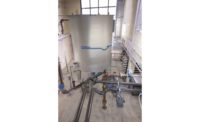In the fall of 2018, the Water Research Foundation (WRF) launched a project to demonstrate the capabilities of CalPrex, a high-rate, pre-digestion phosphorus removal and recovery technology. The project is being conducted in participation with Nine Springs Treatment Plant (Madison, WI), Milwaukee Metropolitan Sewerage District (Milwaukee, WI), Metro Wastewater Reclamation District (Denver, CO) and Massachusetts Water Resources Authority (Boston, MA). Additional participants include Colorado School of Mines (Golden, CO), University of Wisconsin-Madison (Madison, WI), Black and Veatch (Madison, WI), Hazen and Sawyer (Virginia Beach, VA), Centrisys/CNP (Kenosha, WI) and Upcycling (Madison, WI).
The CalPrex technology, licensed from Nutrient Recovery and Upcycling (NRU) by Centrisys/CNP, ran as a 10 gallon per minute pilot system from October through the end of November at Madison’s Metropolitan Sewerage District’s Nine Springs Treatment Plant. As part of the WRF project, the CalPrex system incorporates a thickened sludge fermentation tank or acid digester to increase the amount of soluble phosphorous, thereby increasing the recovery potential of the phosphorus.
Preliminary results indicate a 65% solubilization rate in the fermented sludge after the phosphorous release going to the Ostara process in Madison, Wisconsin. From there, 44% of the total amount of phosphorus was captured, with an 89% soluble phosphorus reduction in the CalPrex reactor. The pilot system’s clarifier effluent had an average of 44mg/L soluble phosphorus. Recovered phosphorus came in the form of brushite or dicalcium phosphate dehydrate. This was harvested and dried on-site for later use in a USDA-funded fertilizer study currently being conducted with Texas A&M University.
Centrisys’s CalPrex process is uniquely suited for recovering a high rate of soluble phosphorus by simply adding calcium hydroxide without ammonium. This is a high value solution for facilities that need phosphorus removal and recovery prior to thermal hydrolysis, waste activated sludge and/or primary sludge prior to anaerobic digestion and post-aerobic digestion.
This pilot program demonstrated the system’s ability to recover high rates of total and soluble phosphorus before the digesters, proving it is a viable solution for utilities seeking to mitigate operations and maintenance issues related to struvite scaling and poor sludge dewaterability. In addition, the project supports efforts NRU is undertaking to establish brushite in the fertilizer market.
In conclusion, results of the project will help water resource recovery facilities better evaluate and benchmark various phosphorus removal technologies available on the market. A peer-reviewed study will be published in late 2019 by the Water Research Foundation elaborating on the CalPrex process performance, benefits, costs and large scale impact.
To see a video of the process, click: https://www.youtube.com/watch?v=NwO2krsLKyg
For more information visit www.centrisys.com



Report Abusive Comment